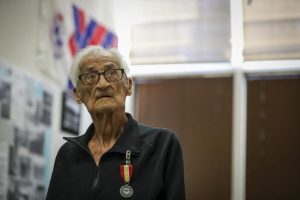The oldest fort west of the Mississippi River is a massive operation that’s been serving the country since 1827.
And though it sits less than 40 miles from downtown Kansas City, Fort Leavenworth is surprisingly easy for many of us to overlook.
That’s ironic, because the fort’s location, high on the Missouri River bluffs, was chosen for its strategic value. (Lewis and Clark noted the merits of the site when they visited in 1804.)
George Pettigrew believes the time has finally come to recognize the vital role Fort Leavenworth played in America’s westward expansion. And still plays today.
As chairman of the Frontier Museum of the U.S. Army Foundation, he’s working to unveil a new world-class facility by 2027, the fort’s 200th birthday.
Pettigrew is the great grandson of a Buffalo Soldier—one of the Black Americans who began serving in the U.S. Army immediately after the Civil War.
At Fort Leavenworth, Buffalo Soldiers manned the 9th and 10th Cavalries. They’re commemorated by a sculpture that Colin Powell dedicated in 1992.
“What happened here changed the world,” Pettigrew says, adding that Buffalo Soldiers were just one aspect of that.
Fort Leavenworth, he’s convinced, was uniquely positioned as both portal and protector for thousands of settlers and explorers who passed through on their way to lands unknown.
It was also place where the military trained some of its finest minds.
“What this fort has meant to the development of the United States exists nowhere else,” Pettigrew states proudly.
Artifacts and exhibits attesting to that history are currently displayed in the Frontier Army Museum—a cramped, low-slung WWII era briefing hall. Even its curator admits many of the fort’s residents and regular visitors probably don’t know the museum exists.
To make matters worse, it’s on the wrong side of the gates.
“Very daunting.” That’s how Brigadier General Bryan Wampler, USA (Retired) describes the process required for most of us to get onto the base. For many civilians, he says, “it’s frightening… and easier for them not to come on.”
That’s why the museum that he and Pettigrew are envisioning will be built outside the gates—still on the fort’s grounds, but without the armed guards.
Ideally, they say, it can be nestled in the midst of hills, trees and trails; an open and inviting structure that’s in sync with the natural world around it.
Robert Riccardi, an architect at the Kansas City design firm Multistudio, knows it can be done. He points to the Crystal Bridges Museum of American Art in Bentonville, Arkansas, and the Theodore Roosevelt Presidential Museum in North Dakota as great examples.
“The easy thing to do would be put it up on the flat land,” Riccardi says while tromping into a ravine just north of Leavenworth’s Metropolitan Avenue. “The more interesting thing is going to be putting it down here.”
Wherever it’s built, and however it looks, after construction is completed, the facility will be turned over to the Center for Military History in Washington, D.C. The center has access to thousands more artifacts in the army’s collection. They’ll create the displays and manage the new museum’s operation going forward.
Won’t all this be incredibly expensive? Most likely.
But Wampler is hesitant to set a price tag until the final designs are chosen. He does say it will present a “significant fundraising opportunity”—one he’s confident that philanthropic organizations and members of the military community worldwide will embrace.
For the Kansas-born brigadier general, this is another of the many things his thirty two years of service prepared him for. As Pettigrew puts it, “The Bryan I’ve gotten to know is a doer. He’s not a talker. You set the mission, you set the mission parameters, then you make it happen.”
“I owe a great deal to the military,” is Wampler’s response. “And if I can give back in a little way, I think it’s worthwhile. And I think it’s very important.”
It’s also important to both he and Pettigrew that the new Museum of the Frontier expands its narrative to include more stories from more perspectives, including those of the Indian tribes whose lands were lost along the way.
“We want to tell a more complete story, not an angry story,” Pettigrew says. “We want to applaud the efforts of all those people—immigrants, the ones that were here first, the ones that came. They all contributed one way or another, and they all have a part.”
©2024 The Kansas City Star. Visit kansascity.com. Distributed by Tribune Content Agency, LLC.
Story Continues
© Copyright 2024 The Kansas City Star. All rights reserved. This material may not be published, broadcast, rewritten or redistributed.
Please rate this CIBA article
Vote






